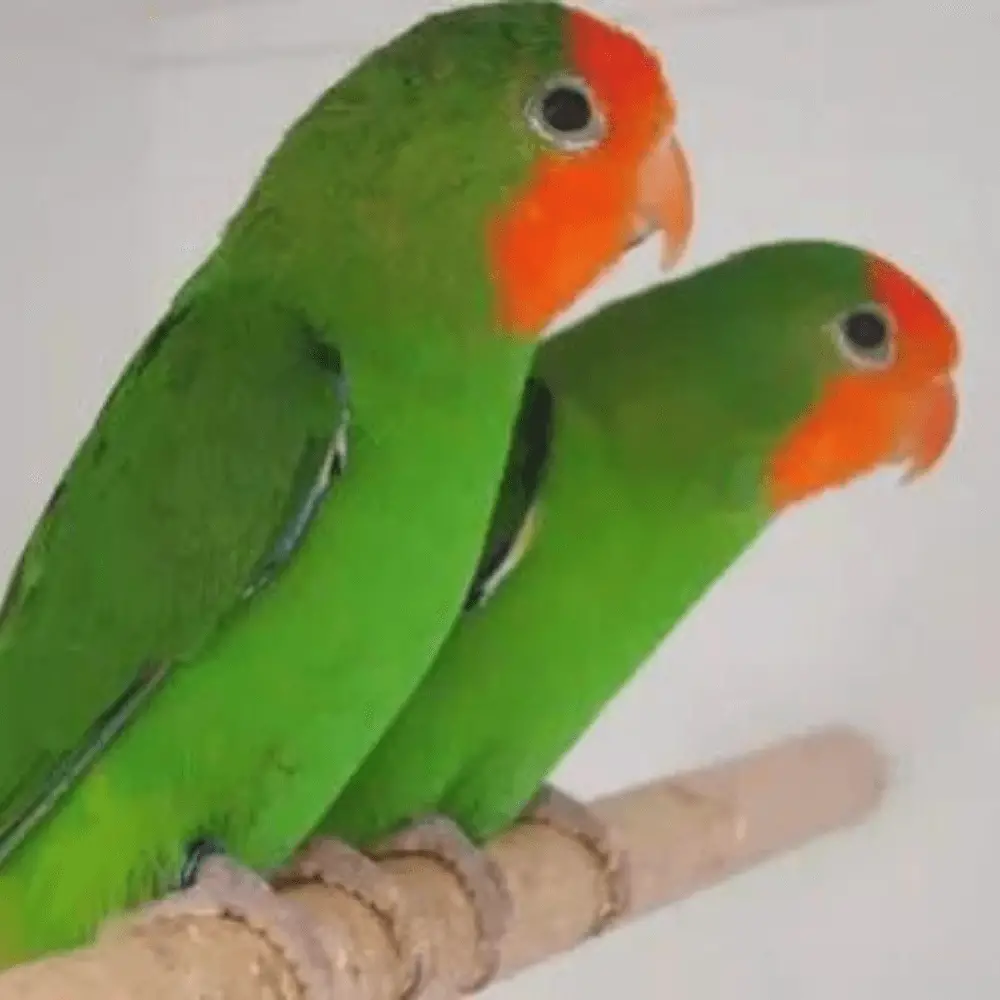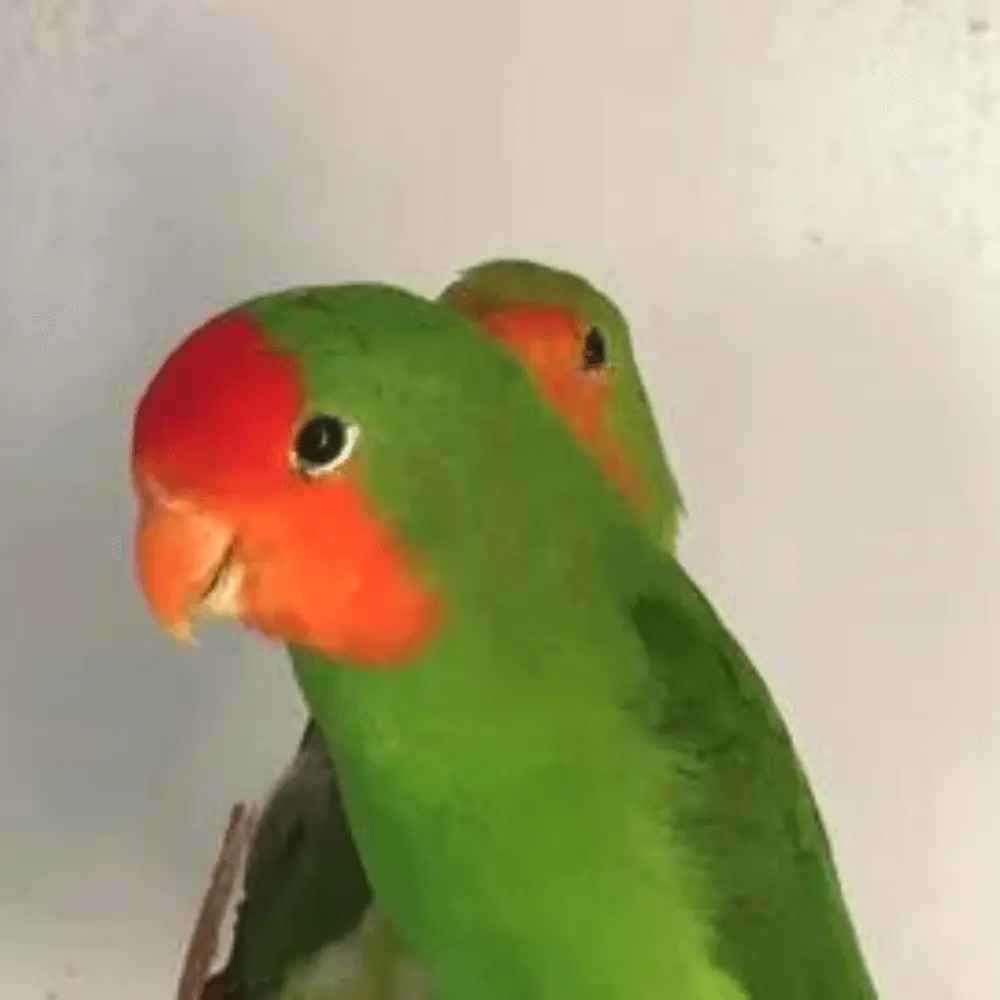Red-headed lovebird: It seems that the lovebird is the fashionable animal these days, and it is not for less, because it is one of the most beautiful birds that exist. But, when choosing one, which is better? If you’re a novice, perhaps you should opt for the lovebird pullaria.
In fact, it’s unclear when this lovebird might start appearing, but it was discovered in 1758 and christened as pullarius lovebird, although it’s commonly called red lovebird for its reddish face which makes it so characteristic.
He is one of the least popular due to his particular way of walking, but that also makes him special. For a long time, they were very common in England and the Netherlands, but due to the lack of success with breeding, interest in this bird has been lost,So it is not very present in the West.
What are its characteristics?
The normal thing is that the plumage of most of its body is green, except for its face which has a red-orange tone. The feathers of its abdomen and undercoat have a more yellowish tone, while the wing area has a black tone. The rump usually has a light blue tint, and the tail is green. Its legs are gray, with a red-orange beak and a dark brown iris. However, some mutations such as the pullarius ugandae lovebird can be found to have a light bluish tint to its rump.
Unlike other variants of the species, the female is easier to tell apart because she exhibits sexual dimorphism, although it is not so pronounced. For example, the color is similar to the male, but the head and eye rim are more orange than red, the main difference is that the color of the underwing wing coverts is green while in the male it is black.
When young, the tone of their feathers is duller and they look very similar to females, which makes it quite difficult to distinguish them. But when you grow up, the males change the green color of the underside of the wings from green to black.
Is it appropriate to have it as a pet?

Many have given up keeping this type of bird due to the difficulty in breeding. However, it is not impossible and as a pet, the truth is that it is very difficult to find a better one.
They are not very violent birds except when in heat or with their partner. They don’t like being around other birds very much. They like to have a place to bathe inside the cage and have their backs petted, to which they respond with gentle head movements.
Their diet is mostly grasses and plant seeds, especially from seeds of the sorghum genus, and also fruits, being their favorite guavas and wild figs. You can also give berries and tree buds.
Distribution
The red-headed lovebird (Agapornis pullarius), also known as the red-headed lovebird, has perhaps the longest range of all lovebirds.
It is found in equatorial Africa, from Sierra Leone to Lake Albert in Uganda. To the west of its wide range, it extends to northern Angola. This species was introduced to Liberia.
This species usually settles at the edge of forests. On rare occasions, it is found in high forests. Outside the breeding season, it usually lives in colonies of up to 30 birds. During the day, they travel long distances in search of food, which usually includes grass seeds, a variety of fruits, and some crops. At night, they return to their common roosts.
Curiously, they have been observed hanging upside down, like bats, from branches to roost or preen on each other. Captive birds have been reported sleeping upside down.
The red-faced lovebird may be the first lovebird imported into Europe.
Description

Size: They average 15cm in length (including the tail) and weigh around 43g (~1.5 oz).
Male:
- Body bright green, bordering yellowish underparts. Lighter underwear in green
- The forehead and face are bright red/orange, extending left and right to the edge of the eyelids, and from the top of the beak on the forehead to the middle of the crown.
- The underside of their wings is black.
- Rump and tail feathers: blue, with small amounts of red, yellow, and black in the tail feathers.
- Has a bright red beak
- Feet and legs are gray
- Brown eyes.
Female:
- The color is similar but generally paler and the red/orange female’s head color is less defined than the male’s.
- It has a paler red beak.
- The underside of its wings is green.
Young people :
- Immature birds have a less extensive facial mask than adults and are yellow-orange in color. The underwing of the male is black and that of the female is green.
- The beak is red-brown with black at the base of the upper beak (jaw).
Vocalizations
Red-headed lovebird calls are low and high-pitched; usually a trill and a trill. We can also hear sharp hissing noises when startled or frightened.
Breeding love birds

The breeding season of Red-headed lovebird depends on the area in which it is found. For example, in Africa, they breed in April, June, and October.
Once they have fallen in love with the female, courtship begins and soon after consumption and after 20 days the female will lay the eggs. It is necessary to provide them with a medium-sized nest since with each laying they can lay 4-5 eggs.
When you remove it from the cage, you must be very careful, especially if you have not yet gained confidence with its owner, because it is a very fast-flying bird.
Although he is very curious, he is also a bit scary, so at no time should you try to catch him if he escapes from the cage. Just close the room to explore, leave your favorite food in the cage and when you’re hungry you’ll go for it.
In their natural habitat, their breeding season begins at the onset of the rainy season. During this period, the birds mate and build nests inside anthills and termite mounds located above ground in trees or sometimes on the ground. The female can dig tunnels up to 30 cm long. They can nest in colonies with other lovebirds.
The preferred materials for building and lining their nests are seed husks, grasses, and shredded leaves, which the female carries by burying them in her feathers.
The average clutch consists of four to five small eggs, which are incubated for about 24 days. Once the young hatch, they will stay in the nest for about 7 weeks before flying off.
Red-faced lovebirds are rare on poultry farms and are difficult to care for. There are only a few red-faced lovebirds in captivity. In the United States, only a handful of breeders have had success with this species. The key to breeding these lovebirds seems to lie in maintaining individual pairs.
Breeding successes are rare, mainly because this nervous species easily succumb to stress, in addition to difficulty in satisfying its specific nesting habits.
This species likes to dig for its nest and the nest chamber should be heated to around 27 degrees Celsius or 80.6 degrees Fahrenheit. Some success has been had by tricking them into borrowing the cork to build a nest.
One breeder, Grant Scopes, has successfully produced offspring. He provided 40 x 20 x 16-inch brood cages and a 16 inch long nest box (the full width of the cage).
The birdhouse has been divided into 2 sections. One section was filled with peat, while the other section had a layer of wood chips and peat placed on the bottom. He observed that the parent birds began to dig the peat, then dug down to the second chamber and began to build a nest using grass and shredded newspaper.
The hen laid two eggs. He observed that these love birds grew surprisingly quickly and confidently. She gave them a variety of fruits, including apples, fresh figs, sweet corn, and piracanthaca berries.
He said the only green food they accept is grass from chickens freshly picked from the garden. He also gave a mix of good quality seeds (including a mix of wild seeds) and some breeding food, sand, and cuttlebones.
SOURCE: Nelson Cruz
Related article:

